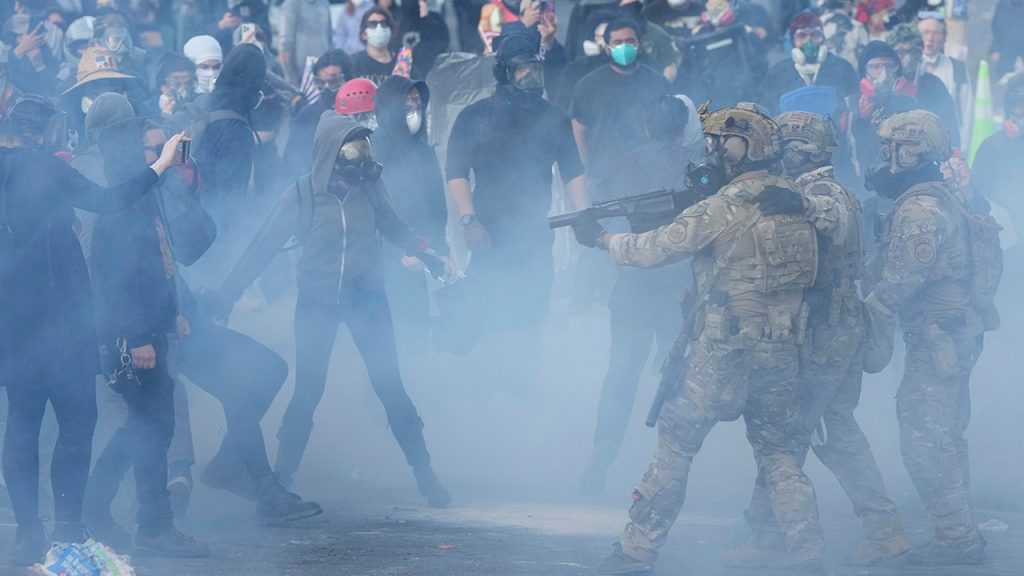On Saturday evening, protests in Portland, Oregon, escalated into a riot near an Immigration and Customs Enforcement (ICE) facility, resulting in multiple injuries and arrests. The Portland Police Bureau reported that four officers sustained injuries during the chaos, which erupted post a “No Kings” protest that attracted tens of thousands of participants earlier in the day. The rapidly deteriorating situation forced police to respond with crowd control measures, leading to multiple arrests and warnings against violent behavior.
| Article Subheadings |
|---|
| 1) Overview of the Protest and Riot |
| 2) Law Enforcement Response |
| 3) Timeline of Events |
| 4) Arrests and Charges |
| 5) Ongoing Investigations and Community Reactions |
Overview of the Protest and Riot
On June 14, 2025, Portland saw a significant turning point when a planned demonstration known as the “No Kings” protest transformed into a violent encounter near an ICE facility. Initially designed to advocate against perceived injustices and demonstrate civil rights, the protest reportedly drew a massive crowd, estimated to be in the tens of thousands. However, as the day transitioned into evening, the atmosphere shifted dramatically. According to the Portland Police Bureau (PPB), the protest began addressing issues regarding the federal government’s immigration policies and treatment of immigrants, which many participants believe violate human rights.
Law Enforcement Response
The PPB responded promptly to incidents of escalating violence near the ICE facility around 6 p.m. Reports indicated that a federal officer had suffered injuries from confrontations with the crowd. Authorities communicated a precautionary message to the protestors, highlighting the need for them to allow medical personnel to attend to the injured officer. Despite these warnings, tensions among demonstrators surged, necessitating a more robust response from police, who eventually categorized the events as a riot due to ongoing criminal activities and lawlessness.
Timeline of Events
The initial protest commenced at 1 p.m. when activists gathered to voice their opinions regarding the current immigration policies in the United States. As the day progressed, speeches and chants filled the Portland air, capturing the attention of both supporters and opposition. By early evening, however, a faction of the protesters commenced throwing objects, including fireworks and rocks, at law enforcement officers—a move that prompted the police to declare a riot shortly thereafter. By 8 p.m., PPB had arrested multiple individuals involved in violent activities.
Arrests and Charges
In the wake of the disturbances, several individuals were detained for their involvement in violent actions. Notably, 25-year-old Sabian Crisantos faced charges for attempted assault on a public safety officer, while 20-year-old Tyson Kahnert was apprehended for throwing rocks at the ICE facility. Additionally, 38-year-old Cory Oien was arrested at 1 a.m. the following day for theft and driving under the influence. Reports from the PPB indicated that many of these arrests were made based on clear evidence of misconduct witnessed by officers at the scene.
Ongoing Investigations and Community Reactions
Following the events of the night, PPB announced that the investigation into the riot would continue, with more arrests anticipated as they gather evidence from the altercations. Community reactions have been mixed, with some expressing outrage at the police’s handling of the protest, while others defend law enforcement’s duty to maintain order. Officials have emphasized that while constitutional rights of free speech must be respected, violent actions will be swiftly addressed to uphold public safety. The unrest in Portland has reignited debates about how protests are policed, especially in the context of civil rights.
| No. | Key Points |
|---|---|
| 1 | Protests transformed into riots near the ICE facility in Portland. |
| 2 | Portland Police Bureau responded to escalating violence and declared a riot. |
| 3 | Multiple arrests were made, including charges related to assault and property damage. |
| 4 | The timeline of events marked clear progression from peaceful protests to violent encounters. |
| 5 | Investigation into the riot is ongoing, with potential for more arrests. |
Summary
The events in Portland serve as a potent reminder of the volatility inherent in large-scale protests, especially those centered around contentious issues such as immigration. While the right to assemble and voice dissent is a crucial aspect of democracy, the escalation into violence poses significant challenges for law enforcement and community relations. As investigations continue, the focus will likely shift towards assessing the accountability of both protestors and law enforcement in maintaining peace and order.
Frequently Asked Questions
Question: Why did the protest escalate into a riot?
The protest escalated into a riot as a faction of demonstrators engaged in violent activities, including throwing objects and fireworks at law enforcement officers, prompting a police declaration of a riot.
Question: What measures were taken by the police during the protest?
The police responded by issuing warnings to the crowd, deploying crowd control measures, and eventually declaring a riot due to ongoing criminal activities.
Question: What have been the community reactions following the events?
Community reactions have been mixed, with some expressing outrage at the police response and others emphasizing the need for order during potentially violent protests.
